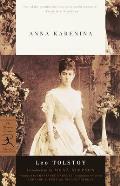
The first translator of
Anna Karenina into English,
Nathan Haskell Dole, was raised in a strict Puritan home in Massachusetts. In his introduction to the
1886 edition, he claims that "the teaching of the story cannot fail to be considered in the highest degree moral and stimulating." Perhaps he was hoping that his literary friends in Boston wouldn't be shocked at his translating a novel that contained multiple adulterous liaisons and a suicide.
What was "moral and stimulating" in 1886 is today "a sexy and engrossing read," according to Oprah's Book Club. Anna herself is described as "the book's namesake and the woman we've all been waiting to meet," which makes her sound as though she's about to step out onto the talk show stage. Oprah picked Anna Karenina for her book club in 2004 and the title vaulted to the top of the New York Times bestseller list, 127 years after its publication in Russia.
Nathan Haskell Dole's translation made Anna Karenina accessible for the first time to the English speaking world. He was not fluent in Russian, which made his job somewhat difficult. The French edition had been published a year earlier and if Dole didn't finish his translation quickly, someone else would be the first to publish Tolstoy in English.
"After the present translation was begun, an anonymous French paraphrase appeared," Dole writes in the introduction to the 1886 edition. "In order to hasten the preparation of this volume for the press, that version has been used in a few passages, but always with the Russian original at hand."
Translation: Dole cribbed from the French edition of Tolstoy's novel and made it to press on time.
 When you read Tolstoy in translation (or any author in translation), what are you reading? The words of the author faithfully transliterated? Or the sentence structure and vocabulary of the translator? Constance Garnett, possibly the most widely read translator of Tolstoy, reportedly omitted words or phrases she did not understand.
When you read Tolstoy in translation (or any author in translation), what are you reading? The words of the author faithfully transliterated? Or the sentence structure and vocabulary of the translator? Constance Garnett, possibly the most widely read translator of Tolstoy, reportedly omitted words or phrases she did not understand.
For her book club, Oprah chose the Pevear and Volokhonsky translation. ''First of all, get this edition,'' she told viewers. "Look for the Oprah's Book Club little sticker there because there's lots of different editions."
There are a lot of different editions. The short list of translations looks like this:
- Anonymous translation from Russian to French in 1885
- Doyle 1886
- Isabel Hapgood 1898
- Constance Garnett 1901
- Louise & Aylmer Maude 1918
- Rosemary Edmonds 1954
- Joel Carmichael 1960
- David Magarshack 1961
- Margaret Wettlin 1978
- Pevear & Volokhonsky 2000
- Kyril Zinovieff 2008
Even the Modern Library edition of Constance Garnett's translation has been re-worked by Leonard Kent and Nina Berberova.
Anna Karenina was the first book chosen by Oprah that she had not yet read. "It's been on my list for years, but I didn't do it because I was scared," she told her television audience. Then she and hundreds of thousands of readers (the print run of the Oprah Book Club edition was over 800,000 copies) conquered their fears and tackled Tolstoy.
The story of Anna Karenina is available in many formats — movies, music videos, ballet, even e-downloads in 423 installments. Whether Anna's story is "moral and stimulating" or "a sexy and engrossing read," it's clear that there's a love affair between Anna Karenina and the reading public.
÷ ÷ ÷
I'm off to lay roses on Tolstoy's grave and will return in January.